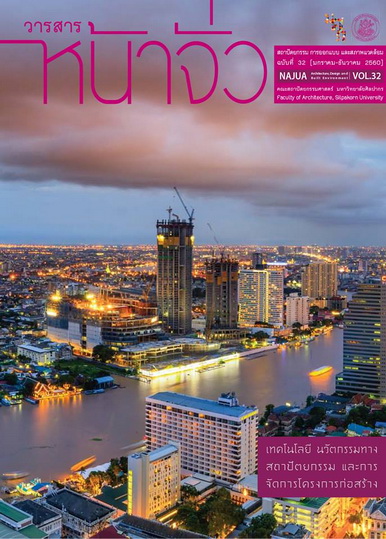ประสิทธิภาพแผงบังแดดหน้าต่างกึ่งโปร่งแสงที่ส่งผลกระทบต่อค่าการถ่ายเทความร้อน
Keywords:
อุปกรณ์บังแดด, แผงบังแดดกึ่งโปร่งแสง, การถ่ายเทความร้อน, shading device, semi translucent shades, heat transferAbstract
การศึกษานี้เป็นการค้นหาประสิทธิภาพการถ่ายเทความร้อนและพฤติกรรมทางด้านอุณหภูมิที่เกิดขึ้นของอุปกรณ์บังแดดที่แตกต่างกัน 4 แบบ คือ 1) อุปกรณ์บังแดดแนวนอนยื่น 0.55 เมตร วัสดุกึ่งโปร่งแสง 2) อุปกรณ์บังแดดแนวนอนและแนวตั้งยื่น 0.55 เมตร วัสดุกึ่งโปร่งแสง 3) อุปกรณ์บังแดดแนวนอนและแนวตั้งยื่น 0.90 เมตร วัสดุกึ่งโปร่งแสง 4) อุปกรณ์บังแดดเปิด-ปิดได้ บานเกล็ดไม้ โดยทำการวิเคราะห์พื้นที่เกิดเงาของอุปกรณ์บังแดดและตรวจสอบอุณหภูมิภายในและภายนอกกล่องทดสอบ กล่องทดสอบบุฉนวนโฟมห้าด้าน อีกด้านหนึ่งติดตั้งหน้าต่างขนาด 1.00x0.50 เมตร และอุปกรณ์บังแดดที่แตกต่างกัน ทดสอบภาคสนามบนชั้นดาดฟ้าอาคารพาณิชย์จังหวัดอุทัยธานี โดยทำการเก็บข้อมูลอุณหภูมิตลอด 24 ชม. ในทิศตะวันออก ตะวันตก เหนือ และใต้ แล้วนำผลมาเปรียบเทียบกัน
ผลการศึกษาพบว่า หน้าต่างที่มีอุปกรณ์บังแดดบานเกล็ดไม้ (แบบที่ 4) มีประสิทธิภาพในการป้องกันความร้อนได้ดีที่สุดและเหมาะกับทุกทิศ แม้จะบังรังสีดวงอาทิตย์ได้ตลอดเวลา แต่ก็มีค่าความแตกต่างอุณหภูมิภายในกล่องกับอุณหภูมิอากาศประมาณ 1-3 องศาเซลเซียส ส่วนหน้าต่างที่มีอุปกรณ์บังแดดกึ่งโปร่งแสงทั้งหมด (แบบที่ 1 2 และ 3) มีประสิทธิภาพในการป้องกันความร้อนตํ่า ส่งผลให้มีค่าความแตกต่างอุณหภูมิอากาศกับอุณหภูมิภายในกล่องทดสอบสูงประมาณ 6-10 องศาเซลเซียส (ทั้งสี่ทิศ) หน้าต่างที่ใช้อุปกรณ์บังแดดกึ่งโปร่งแสง ทั้งแนวนอนและแนวตั้งจะมีค่าความแตกต่างอุณหภูมิภายในกล่องและอุณหภูมิอากาศสูงมากกว่าหน้าต่างที่มีอุปกรณ์บังแดดแนวนอนอย่างเดียว (วัสดุกึ่งโปร่งแสง)
Effect of Semi Transparent Window Shading Devices on Heat Transfer
Vachira Sangrutsamee
Faculty of Architecture, Rajamangala University of Technology Thanyaburi
Tanut Sripanom
Faculty of Technical Education, Rajamangala University of Technology Thanyaburi
This study is aimed at finding the effectiveness of heat transfer and temperature behavior of four types of different shading devices: 1) a 0.55-meter horizontal overhang shading device made of semi-translucent polycarbonate material, 2) a 0.55-meter horizontal and vertical overhang shading device made of semi-translucent polycarbonate material; 3) a 0.90-meter horizontal and vertical overhang shading device made of semi-translucent polycarbonate material; and 4) a window with operable wood louvered shutters. The research analyzed the shading areas of the shading devices and checked internal and external temperatures of the test box. All five sides of the test box were lined with foam insulation panels and another side was installed with different type of window and shading device in a dimension of 1.00x0.50 meter. The field test was conducted on the rooftop of a commercial building in Uthai Thani province and temperatures occurring in all directions - east, west, north and south - during the 24-hours test were recorded and compared.
The findings were that the window fitted with operable wood louvered shutters (type 4) had the highest effectiveness of heat prevention and suited all directions. Although it prevented sunlight all the time, the difference of internal and external temperatures of the box was about 1-3°C. All windows fitted with semitranslucent polycarbonate materials (type 1, 2 and 3) had low effectiveness of heat prevention, so the difference of internal and external temperatures of the box was as high as 6-10°C (in all directions). The window fitted with both horizontal and vertical semi-translucent polycarbonate shading devices had higher internal and external temperatures of the box than that of the window fitted with only horizontal shading device (semi- translucent polycarbonate material).





